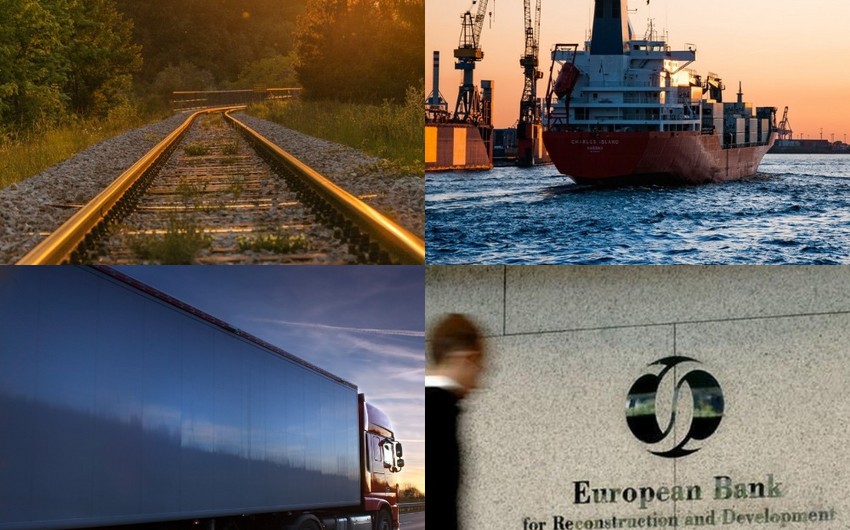The total investment needed to significantly improve the Central Trans-Caspian Corridor (CTCN) - Middle Corridor is estimated at around €18.5 billion, Report informs referring to a study by the European Bank for Reconstruction and Development (EBRD).
These investment needs relate to railway and road network rehabilitation and modernisation, rolling stock expansion, port capacity enhancements, improvements to border crossing points, and multimodal logistics centres and auxiliary network connections in all five countries. Identified investment needs take into account each Central Asian country’s own needs, priorities, capacities and specific conditions.
Total trade between the EU and Central Asia has grown by 38.8% in the last decade, from €34.2 billion in 2012 to €47.5 billion in 2022, with two-thirds of total trade being imports to the EU.
The main products imported by the EU are mineral products, base metals and products made from them, and chemical and associated products (92% of total EU exports). The EU’s main exports to Central Asia are machinery and appliances, chemical or allied products, and transport equipment (70.7% of total EU exports).
"Despite growing European-Central Asian trade, China is the largest driver of cargo volumes between Europe and Asia. It is also one of the EU’s two largest trading partners. Historically, the majority of Europe-China trade in goods has been carried by maritime routes (estimated to be around 80-85% of all EU-China trade volumes), with land-based modes carrying around 10% and air transport carrying the remainder," the report reads.
According to EBRD, overland transport between Asia and Europe is conducted on three main corridors:
"The Northern Corridor between Asia and Europe runs from China through Kazakhstan, Russia and Belarus before entering the EU via Poland. Trains also travel through Mongolia or directly through Russia on the Trans-Siberian railway. This route is about 10,000 kilometres (km) long and the transit time is reported to be 14 days, on average.
"The Trans-Caspian International Transport Route (Middle Corridor) connects Asia and Europe via Kazakhstan and the Caspian Sea. Goods enter the Caucasus through the port of Baku, Azerbaijan, and continue to Georgia, from where two alternative routes can be taken before entering the EU via Bulgaria or Romania: a land-based route via Türkiye or a maritime route via the Black Sea. While shorter than the Northern Corridor, at 7,000 km, it currently involves unpredictable timelines, which may vary from 14 days to 45 days, but can take up to 60 days depending on the circumstances.
"The Southern Corridor traverses the Kyrgyz Republic or Tajikistan, Uzbekistan, Turkmenistan, Iran and Türkiye before entering Europe via Bulgaria or Greece. Another potential route along the Southern Corridor crosses Afghanistan and Central Asia and onwards to the EU via the Caucasus, but this alternative has not been assessed for the purposes of this study for geopolitical reasons. This is a land-based corridor and largely preferred by road carriers, as it avoids the Caspian Sea crossing and the problems associated with it, including port inefficiencies and limited and unpredictable ferry times. Transit times are reported to be around 14-20 days for non-EU destinations, but can take 60 days or more."
The EBRD noted that despite the region’s strategic location and ability to act as a land bridge between the two continents, frequent disruptions to operations, delays (mostly related to crossing the Caspian and Black Seas) and multiple international border-crossing points with unaligned transit procedures preclude container transportation and result in the transportation of mostly time-insensitive commodities on the Central Asian corridors.
According to the assessment, the Middle Corridor is identified as the most sustainable transport link between Europe and Central Asia:
"With its two-layer catchment area - 300 km to the north and south of the Central Trans-Caspian Corridor - the CTCN spans all major economic and population centres in Central Asia and ensures connectivity within the region and with Europe through key transport network links. The CTCN has the greatest potential for further development, as it allows not only for transport network development, but can also support regional development in Central Asia. This region has an extensive transport network, which can serve as the basis for further regional cooperation and coordinated project implementation."


 https://static.report.az/photo/ace96e05-87a6-3363-8e9a-f4091eea4b37.jpg
https://static.report.az/photo/ace96e05-87a6-3363-8e9a-f4091eea4b37.jpg

